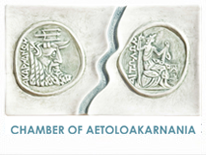|
The presence of the olive in the area of Aetolia, like in the rest of the Mediterranean regions, is lost in the depths of time, in the interglacial eras. The olive tree is closely intertwined with the myths, the folk tradition, the art and the place names of the region. The natural environment has favored the growth and evolution of the olive tree and this is confirmed by the large populations of native wild olive, which feed many olive groves of the country for its traditional propagation. Its roots, trunks and shoots have always been an excellent raw material for wood carving, folk art, the manufacture of tools and special utensils for individual and family use. The olive tree is a real gift of nature in Greece. Olive growing is one of the most environmentally friendly agricultural activities, while its favorable effects on social development are many and important. Aetolian Land, which belongs to the largest prefecture in the country, is one of the most dynamic regions in the cultivation of this wonderful tree with over three million olive trees. The particularly favorable soil-climatic conditions, the diverse geographical division and the microclimate of its individual areas, favor the normal fruiting, the yield, as well as the adaptation of a wide range of varieties such as: Koutsorelia, Koroneiki, Kothreiki, Rahati, Tragolia, Lianolia, Karidolia, Kalamon and Conservolia. The “table” olives of the varieties Kalamon, Conservolia and Karidolia with the solid olive groves, give a unique, tasty product while the oily varieties Koutsorelia, Koroneiki, Tragolia, Lianolia, Rahati and Kothreiki, give high quality oil with special characteristics. Going back to tradition and history, we find that many of the forms in which “table” olives are offered today, have exactly the same way of processing as in antiquity. The “almades” that were kept in brine, the “thlastes” are the crushed olives, the “nectrides” or “vomvia” or “kolimvades” or “stemfilides” are the black one. By the name “rysai” or “driperepis” or “ischades” or “gergemiro” they meant the Wrinkled (Black) Olives. Besides, the “omfakinon” oil was sought after in ancient times, which is the fresh olive oil. Olive oil is the "juice" obtained from the fruits of the tree, by mechanical means and natural processing. It is the main source of fat in the Mediterranean Diet. It has a low content of saturated fatty acids and a high content of monounsaturated fats. It also contains polyphenols, flavonoids, vitamin E, provitamin A, minerals and trace elements. All of these vitamins and minerals work as antioxidants for the body and protect it from damage caused by the oxidation of free radicals. The "Hippocratic Code" contains more than sixty medicinal uses of olive oil, mainly against skin diseases, hair beautification, wounds and burns, gynecological diseases, ear infections, as a mean of contraception, while Plutarch proposes it for treatment of mastitis. |
AETOLEAN PRODUCTS











